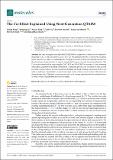Files in this item
The cis-effect explained using next generation QTAIM
Item metadata
| dc.contributor.author | Peng, Yuting | |
| dc.contributor.author | Yu, Wenjing | |
| dc.contributor.author | Feng, Xinxin | |
| dc.contributor.author | Xu, Tianlv | |
| dc.contributor.author | Früchtl, Herbert | |
| dc.contributor.author | van Mourik, Tanja | |
| dc.contributor.author | Kirk, Steven R. | |
| dc.contributor.author | Jenkins, Samantha | |
| dc.date.accessioned | 2022-09-21T10:30:03Z | |
| dc.date.available | 2022-09-21T10:30:03Z | |
| dc.date.issued | 2022-09-18 | |
| dc.identifier | 281321387 | |
| dc.identifier | 13280aec-6424-4507-b42f-65d516c67375 | |
| dc.identifier | 000856892900001 | |
| dc.identifier | 85138394552 | |
| dc.identifier.citation | Peng , Y , Yu , W , Feng , X , Xu , T , Früchtl , H , van Mourik , T , Kirk , S R & Jenkins , S 2022 , ' The cis -effect explained using next generation QTAIM ' , Molecules , vol. 27 , no. 18 , 6099 . https://doi.org/10.3390/molecules27186099 | en |
| dc.identifier.issn | 1420-3049 | |
| dc.identifier.other | ORCID: /0000-0001-6647-4266/work/119628163 | |
| dc.identifier.other | ORCID: /0000-0001-7683-3293/work/119628513 | |
| dc.identifier.uri | https://hdl.handle.net/10023/26047 | |
| dc.description | The National Natural Science Foundation of China is gratefully acknowledged, project approval number: 21673071. The One Hundred Talents Foundation of Hunan Province is also gratefully acknowledged for the support of S.J. and S.R.K. H.F. and T.v.M. gratefully acknowledge computational support via the EaStCHEM Research Computing Facility. | en |
| dc.description.abstract | We used next-generation QTAIM (NG-QTAIM) to explain the cis-effect for two families of molecules: C2X2 (X = H, F, Cl) and N2X2 (X = H, F, Cl). We explained why the cis-effect is the exception rather than the rule. This was undertaken by tracking the motion of the bond critical point (BCP) of the stress tensor trajectories Tσ(s) used to sample the Uσ-space cis- and trans-characteristics. The Tσ(s) were constructed by subjecting the C1-C2 BCP and N1-N2 BCP to torsions ± θ and summing all possible Tσ(s) from the bonding environment. During this process, care was taken to fully account for multi-reference effects. We associated bond-bending and bond-twisting components of the Tσ(s) with cis- and trans-characteristics, respectively, based on the relative ease of motion of the electronic charge density ρ(rb). Qualitative agreement is found with existing experimental data and predictions are made where experimental data is not available. | |
| dc.format.extent | 1531578 | |
| dc.language.iso | eng | |
| dc.relation.ispartof | Molecules | en |
| dc.subject | QTAIM | en |
| dc.subject | NG-QTAIM | en |
| dc.subject | cis effect | en |
| dc.subject | Dihaloethene | en |
| dc.subject | Dihalodiazene | en |
| dc.subject | QD Chemistry | en |
| dc.subject | T-DAS | en |
| dc.subject.lcc | QD | en |
| dc.title | The cis-effect explained using next generation QTAIM | en |
| dc.type | Journal article | en |
| dc.contributor.institution | University of St Andrews. School of Chemistry | en |
| dc.contributor.institution | University of St Andrews. Centre for Research into Equality, Diversity & Inclusion | en |
| dc.contributor.institution | University of St Andrews. EaSTCHEM | en |
| dc.identifier.doi | 10.3390/molecules27186099 | |
| dc.description.status | Peer reviewed | en |
This item appears in the following Collection(s)
Items in the St Andrews Research Repository are protected by copyright, with all rights reserved, unless otherwise indicated.

